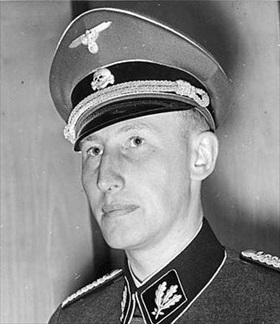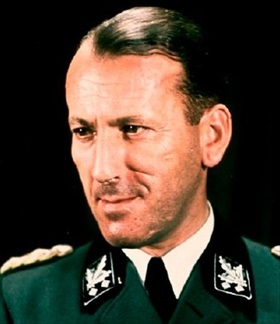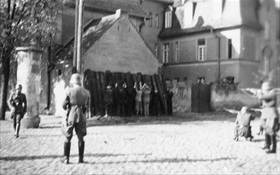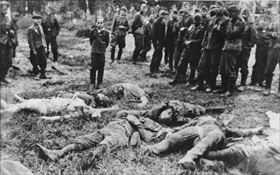NEW REICH SECURITY OFFICE CREATED
Berlin, Germany · September 27, 1937
On this date in 1937 the Reichssicherheitshauptamt, Reich Security Head Office (known by its acronym RSHA), was created by Reichsfuehrer-SS Heinrich Himmler through the merger of the Nazi Party’s Schutzstaffel (SS) intelligence service; the Sicherheitsdienst (SD), or Security Service; and the Sicherheitspolizei (SiPo), or Security Police. The SiPo comprised the notorious Geheime Staatspolizei (Gestapo, or Secret State Police) and the Kriminalpolizei (Kripo, Criminal Police). The first RSHA chief was SiPo head SS-Obergruppenfuehrer (General) Reinhard Heydrich. Heydrich’s security service activities included overseeing foreigners, monitoring public opinion, and Nazi indoctrination. Its stated duty was to find and eliminate “enemies” of the Third Reich. “Enemies” included Jews, Communists, Freemasons, pacifists, and Christian activists.
The RSHA also oversaw the death squads of paramilitary Einsatzgruppen (“task forces”) that followed the invading German armed forces (Wehrmacht) into Eastern Europe. It is estimated that between 1941 and 1945 these death squads and related auxiliary troops (even regular Wehrmacht units acting on their own initiative) murdered more than 2 million people, including 1.3 million Jews, primarily in open-air shootings. Civilians were the main victims. It was the nefarious Heydrich who chaired the January 1942 Wannsee Conference outside Berlin, which drew up plans for the elimination of Jewry in Nazi-occupied Europe. And it was Heydrich’s RSHA that constructed the concepts and operated the administrative apparatus that carried out the Holocaust.
In London the British Special Operations Executive (SOE) and the Czechoslovak government-in-exile drew up a death warrant for Heydrich, who by then was Acting Reich Protector of the Protectorate of Bohemia and Moravia—the part of Czechoslovakia that was incorporated into the Third Reich in March 1939. On May 27, 1942, Operation Anthropoid succeeded in mortally wounding Heydrich, known locally as the “Butcher of Prague.” Eventually the equally intimidating, scar-faced, and volatile-tempered Dr. Ernst Kaltenbrunner moved into the top position at the RSHA, heading that organization until his capture by U.S. forces on May 12, 1945. Tried by the Allies at Nuremberg, Kaltenbrunner was convicted of war crimes and crimes against humanity and executed by hanging on October 16, 1946.
![]()
![]()
The Reich Security Head Office, Its Two Notorious Leaders, and Its Legacy of Death
 |  |
Left: One of the darkest figures in the Nazi pantheon was SS-Obergruppenfuehrer (General) Reinhard Heydrich (1904–1942), head of the Reich Security Head Office (RSHA) from September 1939 to his death. Heydrich served as (of all things!) President of Interpol (International Criminal Police Organization) and chaired the January 1942 Wannsee Conference, which formalized plans for the “Final Solution” to the Jewish Question—the deportation and extermination of all Jews in German-occupied Europe.
![]()
Right: Another President of Interpol was Dr. Ernst Kaltenbrunner (1903–1946). He was an intimidating figure owing to his height, volatile temper, and facial scars (dueling and acne). It was said that even Reichsfuehrer-SS Heinrich Himmler—the second most-powerful person in Nazi Germany—feared him. Kaltenbrunner succeeded the murdered Heydrich as RSHA chief. An Obergruppenfuehrer (general) in the Schutzstaffel (SS) between January 1943 and May 1945, Kaltenbrunner was the highest-ranking member of the SS to face trial at the first Nuremberg Trial (November 1945 to October 1946). He was found guilty of war crimes and crimes against humanity and executed by hanging.
 |  |
Left: Execution of Polish hostages (hard to see but facing wooden beams leaning against the house wall in the middle of the photo) by an Einsatzgruppe (a SS mobile death squad) in Kórnik, occupied Western Poland, on October 20, 1939, a little over one-and-a-half months after the German invasion of Poland. The Kórnik execution was part of Operation Tannenberg, the codename for one of the extermination actions directed at the Polish people. A special unit dubbed Tannenberg was created within the Reich Security Head Office. Conscription lists prepared by Germans before the war identified more than 61,000 members of the Polish elite (activists, intelligentsia, scholars, actors, political and military officers, and others) who were to be interned or shot. Members of the German minority living in Poland assisted in preparing the lists. Operation Tannenberg ended in October 1939 and was responsible for at least 20,000 deaths in 760 mass executions by Einsatzgruppen with some help from regular Wehrmacht units.
![]()
Right: This photo, a copy captioned by the United States Holocaust Memorial Museum, was allegedly taken on July 5, 1941, in Slorow, Ukraine. In it we see a “Jewish” teenager standing just left of center starring at the corpses of his “family.” On both sides are his purported executioners. The photo is reversed and may have been purposely misidentified. The fact remains that in the summer of 1941, four units of Einsatzgruppen, along with reinforcements, were sent to the Soviet Union and murdered approximately one million Soviet civilians in open-air shootings and gas vans. The Babi Yar massacre, which took place in a ravine of the same name in the Ukrainian capital of Kiev, killed 33,771 Jews in a single operation on September 29–30, 1941.
Biography of Reinhard Heydrich, “Hitler’s Hangman”
![]()

 History buffs, there is good news! The Daily Chronicles of World War II is now available as an ebook for $4.99 on Amazon.com. Containing a year’s worth of dated entries from this website, the ebook brings the story of this tumultuous era to life in a compelling, authoritative, and succinct manner. Featuring inventive navigation aids, the ebook enables readers to instantly move forward or backward by month and date to different dated entries. Simple and elegant! Click
History buffs, there is good news! The Daily Chronicles of World War II is now available as an ebook for $4.99 on Amazon.com. Containing a year’s worth of dated entries from this website, the ebook brings the story of this tumultuous era to life in a compelling, authoritative, and succinct manner. Featuring inventive navigation aids, the ebook enables readers to instantly move forward or backward by month and date to different dated entries. Simple and elegant! Click 











